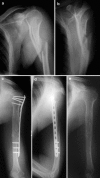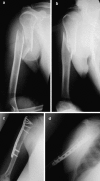Minimally invasive plate osteosynthesis in the treatment of proximal humeral fracture
- PMID: 17033765
- PMCID: PMC2266656
- DOI: 10.1007/s00264-006-0242-4
Minimally invasive plate osteosynthesis in the treatment of proximal humeral fracture
Abstract
The management of fractures of the proximal shaft of the humerus has been evolving since the development of new techniques and new implants in recent years. It seems that this kind of fracture has an increasing incidence in the older, osteoporotic population. In the last 2 years, we have operated on 17 patients, with an average age of 65, who had proximal humeral shaft fractures treated by minimally invasive percutaneous osteosynthesis (MIPO) technique using the metaphyseal locking compression plate. Our study evaluated the surgical technique used and the outcome for these patients with regards to their range of movement and shoulder function. Our results showed that all the patients could achieve at least 140 masculine of shoulder abduction in the first 6 months after the operation, except for three patients who had shoulder impingement. These patients had an average Constant score of 76.8. All fractures had bony union at 6 months, except one, which was probably due to poor reduction in the initial operation. Another complication that we encountered was radial nerve neuropraxia. The ways to prevent these complications are discussed. In conclusion, MIPO fixation using the metaphyseal locking compression plate is a good option for the management of proximal humeral shaft fractures. It provides early functional recovery, but we had to pay special attention to some of the surgical details in order to minimise complications.
La prise en charge des fractures de la diaphyse humérale proximale s’est modifiée depuis le développement de nouvelles techniques et de nouveaux implants. La fréquence de ces fractures semble avoir augmentée dans la population agée et ostéoporotique. Au cours des 2 derniéres années nous avons opérés 17 patients de 65 ans en moyenne, par la technique de l’ostéosynthèse mini invasive per-cutanée (MIPO) en utilisant un plaque métaphysaire à vis verrouillées. Nos résultats montraient que tous les patients atteignaient au moins 140 degrés d’abduction dans les 6 premiers mois sauf trois patients qui avaient un conflit dans l’épaule. Le score de Constant moyen était de 76,8. Toutes les fractures étaient consolidées à 6 mois sauf une probablement à cause d’une mauvaise réduction initiale. La neuropraxie du radial était une autre complication rencontrée. La prévention de ces complications est discutée. Cette technique de traitement permet une récupération fonctionnelle rapide mais nécessite une grande attention des détails pour prévenir les complications.
Figures


References
-
- {'text': '', 'ref_index': 1, 'ids': [{'type': 'DOI', 'value': '10.1016/S0020-1383(01)00076-6', 'is_inner': False, 'url': 'https://doi.org/10.1016/s0020-1383(01)00076-6'}, {'type': 'PubMed', 'value': '11600115', 'is_inner': True, 'url': 'https://pubmed.ncbi.nlm.nih.gov/11600115/'}]}
- Ajmal M, O’Sullivan M, McCabe J, Curtin W (2001) Antegrade locked intramedullary nailing in humeral shaft fractures. Injury 32(9):692–694 - PubMed
-
- {'text': '', 'ref_index': 1, 'ids': [{'type': 'DOI', 'value': '10.1016/j.injury.2004.05.036', 'is_inner': False, 'url': 'https://doi.org/10.1016/j.injury.2004.05.036'}, {'type': 'PubMed', 'value': '15755436', 'is_inner': True, 'url': 'https://pubmed.ncbi.nlm.nih.gov/15755436/'}]}
- Apivathakakul T, Arpornchayanon O, Bavornratanavech S (2005) Minimally invasive plate osteosynthesis (MIPO) of the humeral shaft fracture. Is it possible? A cadaveric study and preliminary report. Injury 36:530–538 - PubMed
-
- {'text': '', 'ref_index': 1, 'ids': [{'type': 'DOI', 'value': '10.1016/S0020-1383(05)80008-7', 'is_inner': False, 'url': 'https://doi.org/10.1016/s0020-1383(05)80008-7'}, {'type': 'PubMed', 'value': '1618565', 'is_inner': True, 'url': 'https://pubmed.ncbi.nlm.nih.gov/1618565/'}]}
- Camden P, Nade S (1992) Fracture bracing of the humerus. Injury 23:245–248 - PubMed
-
- {'text': '', 'ref_index': 1, 'ids': [{'type': 'DOI', 'value': '10.1007/s00264-004-0620-8', 'is_inner': False, 'url': 'https://doi.org/10.1007/s00264-004-0620-8'}, {'type': 'PMC', 'value': 'PMC3474510', 'is_inner': False, 'url': 'https://pmc.ncbi.nlm.nih.gov/articles/PMC3474510/'}, {'type': 'PubMed', 'value': '15714304', 'is_inner': True, 'url': 'https://pubmed.ncbi.nlm.nih.gov/15714304/'}]}
- Chao TC, Chou WY, Chung JC, Hsu CJ (2005) Humeral shaft fractures treated by dynamic compression plates, Ender nails and interlocking nails. Int Orthop 29(2):88–91 - PMC - PubMed
-
- {'text': '', 'ref_index': 1, 'ids': [{'type': 'DOI', 'value': '10.1097/00003086-199805000-00005', 'is_inner': False, 'url': 'https://doi.org/10.1097/00003086-199805000-00005'}, {'type': 'PubMed', 'value': '9602798', 'is_inner': True, 'url': 'https://pubmed.ncbi.nlm.nih.gov/9602798/'}]}
- Crates J, Whittle AP (1998) Antegrade interlocking nailing of acute humeral shaft fractures. Clin Orthop Relat Res 350:40–50 - PubMed
MeSH terms
LinkOut - more resources
Full Text Sources
Medical

